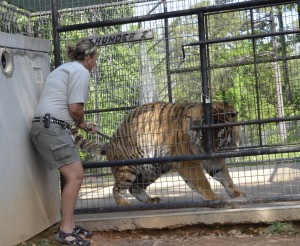When’s the last time you gave a tiger a shot? For Emily McCormack and other staff and interns at Turpentine Creek Wildlife Refuge, the answer was just last week.
“All the animals here receive inoculations once a year and rabies shots every three years,” says McCormack, who is curator at TCWR. “They are subject to the same diseases any cat might be, including feline rhinotracheitis, calici and panleukopenia viruses. The medication we use, Fel-o-Vax, covers those things.”
Vaccinating the animals is not the most fun task in the world. “You have to use a pole syringe to inject them,” McCormack says. “It’s the same gear we use to sedate them when we have to do a rescue and have to tranquilize the cat to move it, although with the inoculations we use a much smaller needle because it’s only a 1 cc shot.”
Nonetheless, she says, the tigers do not like being stuck. “You have to sneak up on them,” she says. “It’s probably like a bee sting would be to us, but some of them get very indignant.”
As a way to avoid the big cats associating the pain of the injection with any one person, everybody rotates giving shots.
“Everybody has a favorite cat, so we do allow you to opt out of sticking your favorite,” McCormack says. “We want them to trust us, and typically the next time you’re around, after you’ve given one a shot, they shoot you a look, but usually after that, all is forgiven.”
Beyond simple vaccinations, the exotic population of TCWR receive continual medical attention from the staff and a local veterinarian.
“We keep an eye on them closely,” McCormack says. Antibiotics are used as needed for infections and other appropriate problems, and as the cat population ages, managing for pain becomes an issue.
“Over 50 of our cats are on a geriatric pain management plan,” she says. “We consult with our vet to decide which animals get what for arthritis. Because many of them are declawed, they develop arthritis in their spines when older. Many take 4-8 pills a day for their issues.”
These medications include anti-inflammatories for pain and neutraceuticals, products that range from isolated nutrients to dietary supplements and herbal products. Because many of the cats growing up were fed nutritionally poor or inappropriate diets, these latter items are added to their diets now for issues such as bone density.
“The goal is to keep them healthy and comfortable, which is part of giving them a home here,” says McCormack. “We do everything we can.”
“The inoculations alone are $20-30 per cat,” McCormack says. “And the other medications vary widely in price for over 100 exotic big cats and animals. It isn’t cheap to pay their vet bill.”
To donate toward medical expenses of our big cats, you can adopt or sponsor a cat today here:

